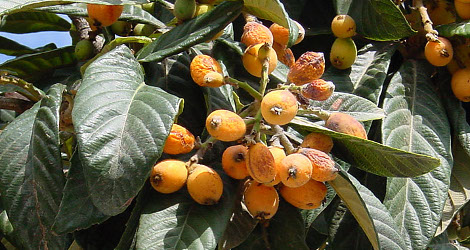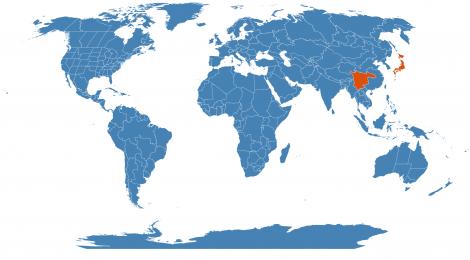Accession Data:
Eriobotrya japonica (Thunb.) Lindl.
- Common Name: Loquat
- Family: Rosaceae Juss.
- Description: Indigenous to China, transported to Japan and cultivated extensively, this medium-sized landscape tree has fruit that is just as valuable as the tree's color and form. The evergreen leaves are large, fuzzy and rust-colored underneath. The fruit is a golden yellow oblong to sphere with sweet/acid white flesh surrounding 1 to 5 shiny brown seeds.
- USDA Zone: 8-10
Accession Data:
- Accession # 198502807
- Source: Unknown
- Recorded Vouchers:
- Voucher 129183 at George Safford Torrey Herbarium (CONN). Specimen collected 10 February 2005. Herbarium Image
- Voucher CONN00160215 at George Safford Torrey Herbarium (CONN). Specimen collected 10 November 1968. Herbarium Image
- Accession Date: 12-31-1985
- Bench: 1207 - AUS:East Bench NC
- Currently: active - marginal
- Qty: 1 confirmed on 04-29-2019
- Restrictions:
- Poisonous Plant Parts - Not for Human Consumption
The seeds of Loquat are poisonous if ingested.
- Poisonous Plant Parts - Not for Human Consumption
Classification:
- Division: Magnoliophyta
- Class: Magnoliopsida
- SubClass: eurosid I
- Order: Rosales
- SubOrder:
- Family: Rosaceae
- SubFamily: Amygdaloideae
- Tribe: Maleae
- SubTribe:
Flowering Data:
This accession has been observed in bloom on:| Year | Jan | Feb | Mar | Apr | May | Jun | Jul | Aug | Sep | Oct | Nov | Dec | ||||||||||||||||||||||||||||||||||||||||
|---|---|---|---|---|---|---|---|---|---|---|---|---|---|---|---|---|---|---|---|---|---|---|---|---|---|---|---|---|---|---|---|---|---|---|---|---|---|---|---|---|---|---|---|---|---|---|---|---|---|---|---|---|
| 2019 | ||||||||||||||||||||||||||||||||||||||||||||||||||||
| 2018 | ||||||||||||||||||||||||||||||||||||||||||||||||||||
| 2017 | ||||||||||||||||||||||||||||||||||||||||||||||||||||
| 2016 | ||||||||||||||||||||||||||||||||||||||||||||||||||||
| 2015 | ||||||||||||||||||||||||||||||||||||||||||||||||||||
| 2014 | ||||||||||||||||||||||||||||||||||||||||||||||||||||
| 2013 | ||||||||||||||||||||||||||||||||||||||||||||||||||||
| 2012 | ||||||||||||||||||||||||||||||||||||||||||||||||||||
| 2011 | ||||||||||||||||||||||||||||||||||||||||||||||||||||
| 2010 | ||||||||||||||||||||||||||||||||||||||||||||||||||||
| 2009 | ||||||||||||||||||||||||||||||||||||||||||||||||||||
| 2008 | ||||||||||||||||||||||||||||||||||||||||||||||||||||
| 2007 | ||||||||||||||||||||||||||||||||||||||||||||||||||||
References (internal):
- Edible Plants
- Plants with Edible Fruits
- Type Species
- EEB 3271 - Systematic Botany
- Plants with Vouchers deposited in CONN
- EEB Greenhouse Holdings native to: China South-Central / Japan
References (external):
- Loquat at California Rare Fruit Growers. Last accessed on Tuesday, March 01, 2016.
- The Plant List (2013). Version 1.1. Accessed 31 March 2105.
- Morton, J. 1987. Loquat. p. 103–108. In: Fruits of warm climates. Julia F. Morton, Miami, FL. Last accessed on Tuesday, March 01, 2016.
- Poisonous Plants at University of California. Last accessed on Wednesday, July 05, 2017.
- Image #00 (cropped) & #02 (original) by Wouter Hagens (Own work) [Public domain], via Wikimedia Commons. Last accessed on Tuesday, November 14, 2017.
- Eriobotrya japonica at ARS-GRIN. Last accessed on Tuesday, November 14, 2017.
data regenerated on Mon, 29 Apr 2019 13:42:02 -0400 [bcm v4.0]
Images:

Additional images for this accession:
Click on thumbnails to enlargeCurrent Accessions in the Rosaceae
Subfamily Amygdaloideae
Tribe Amygdaleae
Subfamily Amygdaloideae
Tribe Maleae
Subfamily Amygdaloideae
Tribe Spiraeeae
Subfamily Dryadoideae
Tribe Dryadeae
Subfamily Rosoideae
Tribe Colurieae
Subfamily Rosoideae
Tribe Potentilleae
- Fragariinae: Duchesnea indica


- Fragariinae: Fragaria chiloensis W/C


Subfamily Rosoideae
Tribe Rubeae
Subfamily Rosoideae
Tribe Sanguisorbeae
- Agrimonilinae: Agrimonia eupatoria

 = indicates flowering in past 14 days
= indicates flowering in past 14 days
 = images available for this accession
= images available for this accession
 = map available for this accession
= map available for this accession
 = accession added within past 90 days
= accession added within past 90 days


